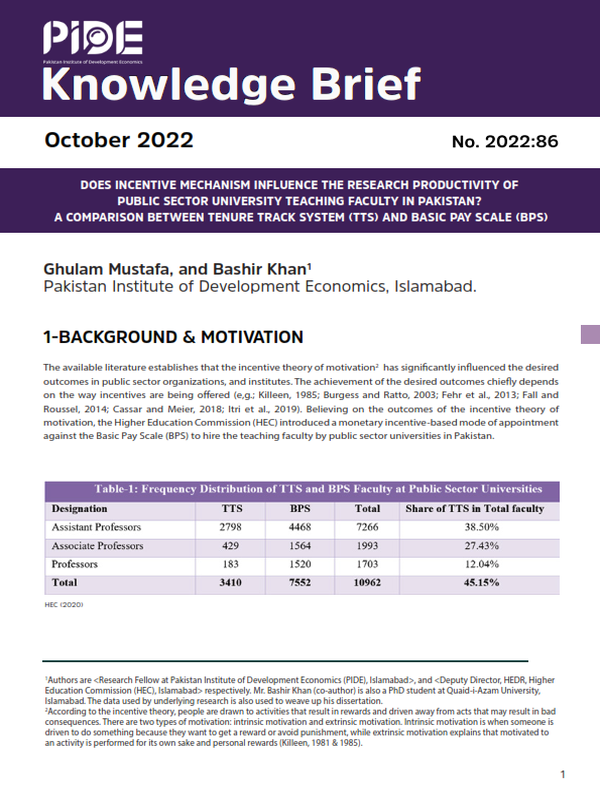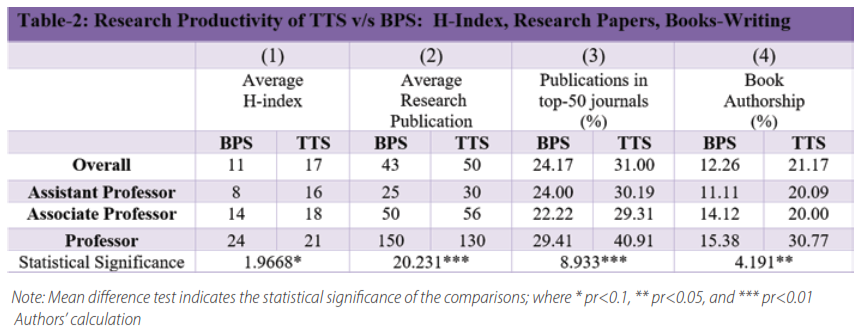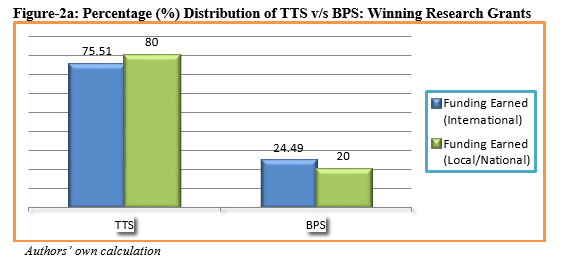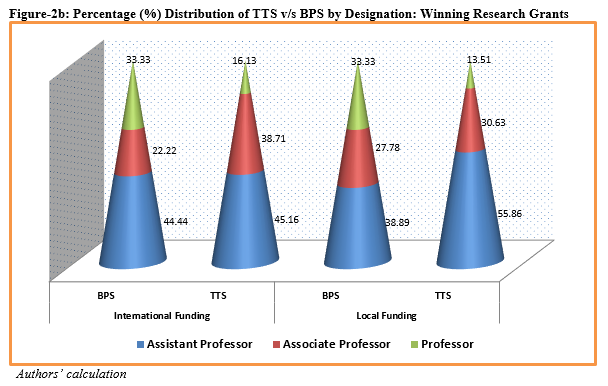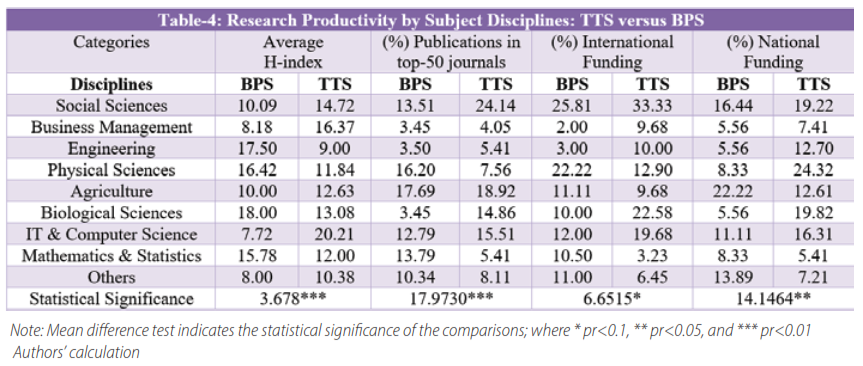Does Incentive Mechanism Influence the Research Productivity of Public Sector University Teaching Faculty in Pakistan? A Comparison between Tenure Track System (TTS) and Basic Pay Scale (BPS)
Ghulam Mustafa, and Bashir Khan[1]
1-Background & Motivation
The available literature establishes that the incentive theory of motivation[2] has significantly influenced the desired outcomes in public sector organizations, and institutes. The achievement of the desired outcomes chiefly depends on the way incentives are being offered (e,g.; Killeen, 1985; Burgess and Ratto, 2003; Fehr et al., 2013; Fall and Roussel, 2014; Cassar and Meier, 2018; Itri et al., 2019). Believing on the outcomes of the incentive theory of motivation, the Higher Education Commission (HEC) introduced a monetary incentive-based mode of appointment against the Basic Pay Scale (BPS) to hire the teaching faculty by public sector universities in Pakistan.
_______
[1] Authors are <Research Fellow at Pakistan Institute of Development Economics (PIDE), Islamabad>, and <Deputy Director, HEDR, Higher Education Commission (HEC), Islamabad> respectively. Mr. Bashir Khan (co-author) is also a PhD student at Quaid-i-Azam University, Islamabad. The data used by underlying research is also used to weave up his dissertation.
[2] According to the incentive theory, people are drawn to activities that result in rewards and driven away from acts that may result in bad consequences. There are two types of motivation: intrinsic motivation and extrinsic motivation. Intrinsic motivation is when someone is driven to do something because they want to get a reward or avoid punishment, while extrinsic motivation explains that motivated to an activity is performed for its own sake and personal rewards (Killeen, 1981 & 1985).
_______
According to the HEC (2020)[3], 3410 teaching faculty is working under TTS, while 7552 are BPS in public sector universities. Out of the total Ph.D. faculty, 45.15 percent of faculty is working under TTS, which reveals that still, almost 55 percent of the total faculty comes from BPS at public sector universities. Furthermore, the distribution of faculty by designation demonstrates that 2798 assistant professors are working as TTS (38.50% of total faculty), 429 associate professors (27.43% of total faculty), and 183 are working as full professors (12.04% of total faculty) at public sector universities (table 1).
The commission aims to increase the induction of TTS faculty, because the HEC has faith in the proliferation of the quality of teaching and research in public sector universities owing to the incentives being offered through TTS. Moreover, the commission expects the spillover influences of TTS on the research productivity of the BPS faculty members (HEC, 2020). The induction of tenure-based faculty has divided the teaching faculty into two evident groups in public sector universities due to the difference in monetary and non-monetary incentives. According to All Pakistan BPS Universities Teachers Association[4], the TTS policy has brought about unnecessary discrimination between BPS and TTS faculty, whereas they are performing similar duties as TTS faculty is doing. HEC has a different point of view, because the commission stands by its policy due to its belief in the framework of the incentive theory of motivation to enhance the research productivity among not only the TTS faculty, but the whole department of the university also. The global practices of hatching monetary and non-monetary incentives in the education sector have shown beneficial impacts on the outcomes such as research productivity and quality of teaching in developing countries (e.g.; Jurges, 2005; Kemnitz, 2007; Nafukho et al., 2019; Wu et al., 2020; Xierali et al., 2020 Chen et al., 2021; Sanmorino and Karimah, 2021; Malul et al., 2021).
The above discussion has motivated us to evaluate the effectiveness of the TTS policy to answer the question such as: comparing the research productivity of TTS faculty relative to the BPS, which would further indicate the effectiveness of the incentives offered by the HEC to increase research productivity.
2-An Overview: Incentive Mechanism of TTS & BPS
HEC introduced Tenure Track System (TTS) in 2003 against already the existing Basic Pay Scale (BPS). Only a few universities started implementing the TTS in 2005. The initial version of “Tenure Track Statutes” was implemented in 2003. This initial draft was redesigned, and the final version of the “Model Tenure Track Statutes, version 2.0” was implemented in 2008, which remains effective to date. The commission borrowed the concept of TTS from the tenure track appointment system, working at American universities. And, the HEC has amended the tenure system according to the local contexts of Pakistan. The key distinctive feature of the American tenure relative is that the faculty members are entitled to free speech and inquiry without the apprehension of termination or revengeful actions from within or outside their universities. Nonetheless, our version of the tenure track does not provide such protections to teaching faculty[5].
Primarily, the TTS policy was designed by the HEC to attract well-qualified teaching faculty for public sector universities. Moreover, the TTS policy is supposed to change the mindset of academia toward research output. The changed mindset would affect not only the productivity of the TTS, but the productivity of those who are working under the BPS system. The commission expected that with time, the two systems could converge into a single highly competitive system to make recruitment, retention, and promotion (HEC, 2020, Khan et al., 2021).
_______
[3] https://hec.gov.pk/
[4] http://apubta.org/
https://thefrontierpost.com/
[5] https://www.geo.tv/
_______
Incentives & Eligibility Criteria of Tenure Track System (TTS) Policy
Primarily, TTS policy is based on the choice of the employee whether he/she wants to opt for BPS or TTS. They are given relatively higher salaries as compared to BPS faculty at public-sector universities. Salary packages for TTS are revised on 20-09-2021. The salient features of salary revision are outlined as follows.
o Salaries of TTS faculty are increase.
o The gap between BPS and TTS will be maintained by 35 percent at least.
o Moreover, up to 15 percent of TTS faculty would be eligible for a 100 percent increase who meets the additional benchmarks of “H-index of 25”, and 5000 citations.
The description of the salary packages and eligibility criteria for hiring TTS faculty at public-sector universities by designation is given as follows.
1.1. Assistant Professor
o Ph.D. in a relevant field is required
o No experience or minimum publication is required for hiring.
1.2 . Associate Professor
o PhD in relevant field is required
o have 6 years’ experience post-PhD/terminal degree.
o Or minimum of 4-years of post-PhD experience with at least 6 years of experience prior to the PhD.
o 10 research publications are also required for promotion to Associate Professor, with at least four research publications in the past 5 years in reputed international journals.
1.3 Professor
o PhD. relevant terminal degree from a recognized local or foreign reputable university/institution
o 11 years Post Ph.D. experience, or 7 years in those cases where a prior PhD experience is of 12 years.
o The experience should be of teaching or research in the relevant domain in the field from national or international organization
o Furthermore, 15 research publications (with at least 5 publications in the past 5 years)
The evident differences in incentive framework offered through both TTS and BPS policies have hatched a debate on the nature of the monetary and non-monetary incentives among the teaching community. Those who are supporters of the BPS such as All Pakistan BPS Universities Teachers Association (APUBTA) have pointed out that BPS faculty are obtaining low salaries, late promotions, and lack of performance-based incentives, although they must work equivalent to the TTS. The promotions of the BPS faculty are granted on a seniority basis regardless of their higher qualifications, and several faculty members must be retired as assistant professors due to the unavailability of senior positions. The BPS faculty takes social security such as pensions, and health benefits, while the TTS policy does not offer social security to the teaching faculty in public sector universities.[6]
Contrary to this, the TTS policy offers a more competitive and attractive system for recruitment, promotion, and tenure than BPS. The TTS encompasses some monetary and non-monetary incentives: high salaries, and speedy promotions, which are conditional to publishing research papers in journals recommended by HEC and teaching some courses as well. There is a strand of TTS faculty that has raised their concerns about the exclusion of benefits like social security. Moreover, some TTS faculty wants relaxation in standards such as the number a published research paper, and acceptable journals. Standards related to the TTS policy are already lower than international yardsticks. So further lowering it would lead to the deterioration of the already compromised quality of research.
Khan et al., (2021) have suggested that despite the attractive salary packages, teachers who are working under TTS are not happy due to the non-availability of pensions and the uncertainty of losing job. In Pakistan, early career BPS teaching faculty longs for higher salaries, and speedy promotions offered by the TTS policy. According to HEC (2020), some teachers have shifted from BPS to TTS mode of employment. The second strand of the employees who are in mid-career of TTS faculty is found wishing for job security and pensions after retirement as a BPS faculty member. Therefore, the debate on BPS versus TTS policy is expected to be carried on.
______
[6] https://www.thenews.com.pk/
______
Data & Methodology
1-Data Description
For empirical purpose, we have surveyed to all public-sector university teaching faculty through emails. Only, 359 university teaching faculty responded to the survey. Out of the total sample, 67 percent comes of TTS faculty, while 33 percent comes from BPS faculty. Moreover, out of total sampled TTS faculty, 41 percent are those who converted themselves from BPS to TTS. The survey contains information about their research activities. Productivity is measured through research paper publications, H-index, book authorship, paper presentation at local and international conferences, and projects winning from national and local agencies. For cross-verification, responses on H-index and detail of publications are confirmed through Google Scholar and other online sources.
1.1 Survey Limitations
i. Despite best efforts, the sample size could be relatively small.
ii. There could be self-selection bias due to two main possible reasons. Firstly, the higher participation of the TTS relative to the BPS faculty members in the survey for this study could influence the outcomes of the underlying study. Secondly, as the TTS policy was meant for the existing BPS faculty also, which possibly fosters some motivated/hardworking BPS faculty members to switch themselves from BPS to the TTS. This could be a potential source of selection bias.
iii. Faculty working under TTS could have an advantage in increasing the number of publications due to their TORs. To avoid it, the study includes other measures of the research productivity such as H-index, book authorship, paper presentation at local and international conferences, and projects winning from national and local agencies. These measures reduce the chances of selection and other survey biasedness.
iv. The survey is designed to estimate research productivity. So, the study maintains focuses only on measuring research activities, while it does not measure the dimensions of quality of teaching, which is also an important component of TTS policy.
v. The survey contains cross-sectional data; this does not reflect the annual performance of the university professors. If we have the data of the annual research publication, then we would have compared the productivity of TTS faculty with its performance in the base year.
2-Methodology for Data Analysis
Primarily, the analysis is conducted by descriptive analysis such as cross tabulation, mean frequencies, etc. Moreover, the mean differences are tested through Z-statistic for mean difference, while Pearson Chi^2 is applied to percentage differences obtained through cross-tabulation, etc. to statistical significance.
3- Research Productivity of TTS v/s BPS Faculty: A Situational Analysis
The findings obtained from the survey indicate that sampled TTS faculty relative to BPS is producing, on average, more research papers—TTS faculty has an average of 50 research papers, while BPS faculty has on average 43 papers. The total number of research paper publications does not determine the quality. We have measured the publication in the top-50 journals specified by the HEC to determine the quality of research work published. The survey unleashes that on average, 31 percent of the TTS faculty are found publishing their papers in top-50 journals, whereas around 24 percent of the sampled BPS faculty is involved in getting published their work in top-50 journals.
Likewise, H-index is also measured which determines the research productivity, demonstrating that TTS faculty relative to BPS contains higher scores on average H-index (table-2). These estimates show that the TTS faculty relative to BPS has out as relatively more productive in terms of H-index and research paper publications. In addition to research publication and H-index, the survey discloses that 21.17 percent of the TTS faculty indulged in book-writing, whereas only 12.26 percent of BPS faculty are found in book-writing, which makes it evident that both TTS and BPS are not looking as good in book-writing as they are in research publications.
Winning research projects measure the research skills of any researcher. The survey demonstrates that TTS v/s BPS are found are to be involved more in winning research funding from local/national or international agencies. Figure-2a depicts that between 75 and 80 percent of the TTS are involved in winning research funding from national and international donors respectively, while only 20 percent and 24.49 percent of the total sampled BPS faculty are found winning projects from national and international donors respectively.
Paper presentation at local and international conferences measures the quality of research works as well as communication and presentation skills. So, the findings obtained from the survey show that TTS faculty relative to BPS are participating more in presenting their research papers at both local and international conferences (table 3).
3.1- Research Productivity by Designation of TTS and BPS Faculty
The survey indicates that the assistant professor of the TTS relative to the BPS counterpart appeared to be more productive in terms of H-index, research publications, and book-writing (see table-2). Similarly, assistant professors of TTS are found more contributing in presenting papers at local and international conferences (see table 3) and winning more research grants or projects from local and international agencies as compared to the counterpart BPS (see figure 2b). Similar the sort of findings can be witnessed for the associate professors working under the TTS policy as compared to the associate professors working under BPS.
Contrary to the assistant and associate professors, the research productivity of the full professor (BPS-21) relative to the TTS full professor is found a relatively higher in terms of H-index, and several research publications (see table-2). Nonetheless, TTS full professor relative to the BPS has higher performance in publishing research papers in top-50 journals and book-writing, which demonstrates the professors working under TTS are producing relatively more quality works as compared to the BPS (see table-2).
Furthermore, full professors working under BPS relative to the TTS are involved in winning more research funding from national and international donors (see figure-2b). Similarly, BPS professors are found presenting relatively more papers at local and international conferences as compared to the TTS full professors (see table 3).
3.2 Research Productivity by Subject Disciplines: TTS v/s BPS
We have disaggregated the data by subject disciplines[7] to explore the performance of TTS faculty relative to BPS concerning their subject disciplines. The findings demonstrate that TTS faculty relative to BPS from Social Sciences, Business Management, Agriculture & Veterinary Sciences, and IT & Computer Science is found to contain higher H-index & publication in the top 50 journals.
Nonetheless, the BPS faculty relative to the TTS from Mathematics & Statistics, Biological Sciences, Physical Sciences, and Engineering has higher research productivity in terms of H-index & publication in the top 50 journals (Green-highlighted part in table-4).
______
[7] We have used eight disciplines as per HEC classification such as Social Sciences, Business Sciences, Physical Sciences, Engineering, Biological Sciences, Agriculture & Veterinary, IT & Computer Sciences, Mathematics & Statistics, and others.
______
BPS faculty relative to the TTS from Mathematics & Statistics are surpassing in performing all measures of the research productivity—higher average H-index, on an average higher number of publications in top-50 journals, and projects winning from national/local and international agencies (Red-highlighted part in table-4).
Moreover, BPS relative to TTS faculty from Agriculture & Veterinary are showing better performance in winning research grants or projects from local and international agencies. Contrary to this, TTS faculties relative to BPS from Biological Sciences are found more immersing in winning research grants (table-4).
5-Concluding Remarks
- By and large, the analysis of the whole sample reveals mixed findings. When the study employs a whole sample, the findings suggest that on average, sampled TTS faculty relative to the BPS is found more productive in terms of research paper publications and H-index, book-writing, winning research grants from local and international agencies, and presenting research papers at local and international conferences. However, when the whole sample is disaggregated by designation and subject disciplines, in some cases, we have failed to find a relatively better performance of the TTS faculty.
- Analysis by designation indicates that assistant professors working under the TTS relative to BPS have shown higher on all measures of research productivity. Similarly, the associate professors working under the TTS are found to be more performing in research productivity than associate professors working under BPS.
- By and large, full professors (BPS-21) relative to TTS counterparts have shown relatively higher research productivity.
- The disaggregation of the sample by subject disciplines demonstrates that by and large, BPS faculty relative to TTS from Natural Sciences is found more productive in terms of H-index and publication of research papers. Similarly, BPS faculty relative to TTS from Mathematics & Statistics has outperformed in all measures of the research productivity used by this study. Nonetheless, TTS faculties relative to BPS from Social Sciences, Business & Management, and IT & Computer Science have shown higher research productivity.
- Hence, given the limitations of the study and the above-mentioned discussion, we can hardly conclude that TTS policy brings about an increase in research productivity of the TTS relative to the BPS. In some cases, BPS is performing well, while in some cases, TTS faculty are performing more than BPS as we have established in previous discussion. An extensive data is required to further improve the quality of the ongoing research, which cannot be the done without additional resources.
6-Way Forward
- Primarily, TTS policy is pertained to the fixed incentives, which indicates that TTS faculty is to meet the minimum requirement of research publication and teaching activities. Beyond that minimum requirement, the TTS faculty has no vivid incentive to participate in research activities such as meeting local demands, knowledge creation, and contributing to wellbeing of the local communities. They just look busy in meeting the minimum requirements as specified by the HEC. So, the commission needs to hatch the cumulative incentives, which must be linked with quality and impactful research work annually regardless of designation.
- As Box-1 is exhibiting that the commission has revised the incentives for 15 percent faculty by offering 100 percent increment to TTS faculty if they meet the additional benchmarks of “H-index 25, and 5000 citations. The H-index criteria contains some problems such as: i) this does not capture whether the work of the researcher has impact on society and meeting the local requirements or not, ii) faculty from Social Sciences may hardly achieve it, and high impact international journals may not publish the paper of Pakistani researcher from Social Sciences because our local economic and social challenges are quite different. So, the commission must revise this criterion and make to more inclusive and impactful.
- To measure research productivity, the HEC must compute an index based on indicators which measure the quality and impactful work as we have described above. This index could provide the ranking of the teaching faculty, which could help to comprehend the quality of work. Moreover, this index would also be implemented on BPS faculty as well, which create a competitive environment between BPS and TTS. The high performing researchers must be given some additional incentives and benefits.
References
- Burgess, S., & Ratto, M. (2003). The role of incentives in the public sector: Issues and evidence. Oxford review of economic policy, 19(2), 285-300.
- Cassar, L., & Meier, S. (2018). Nonmonetary incentives and the implications of work as a source of meaning. Journal of Economic Perspectives, 32(3), 215-38.
- Chen, A., & Wang, X. (2021). The effect of facilitating interdisciplinary cooperation on the research productivity of university research teams: The moderating role of government assistance. Research Evaluation, 30(1), 13-25.
- Fall, A., & Roussel, P. (2014). Compensation and work motivation: Self-determination theory and the paradigm of motivation through incentives.
- Fehr, E., Herz, H., & Wilkening, T. (2013). The lure of authority: Motivation and incentive effects of power. American Economic Review, 103(4), 1325-59.
- Itri, J. N., Bruno, M. A., Lalwani, N., Munden, R. F., & Tappouni, R. (2019). The incentive dilemma: Intrinsic motivation and workplace performance. Journal of the American College of Radiology, 16(1), 39-44.
- Jürges, H., Richter, W. F., & Schneider, K. (2005). Teacher quality and incentives: Theoretical and empirical effects of standards on teacher quality. Finanzarchiv/Public Finance Analysis, 298-326.
- Kemnitz, A. (2007). University funding reform, competition, and teaching quality. Journal of Institutional and Theoretical Economics (JITE)/Zeitschrift für die gesamte Staatswissenschaft, 356-378.
- Khan, B. K., Mustafa, G., & Nawaz, A. (2021). Flourishing the Higher Education in Pakistan: An Exploratory Analysis of The Role of Higher Education Commission (HEC). Journal of Applied Economics and Business Studies, 5(3), 1-18.
- Malul, M., Rosenboim, M., & Shapira, D. (2021). Are Very High Salaries Necessary for Achieving Economic Efficiency? Journal of Behavioral and Experimental Economics, 94, 101725.
- Nafukho, F. M., Wekullo, C. S., & Muyia, M. H. (2019). Examining Research Productivity of Faculty in Selected Leading Public Universities in Kenya. International Journal of Educational Development, 66, 44-51.
- Sanmorino, A., & Karimah, F. (2021). A Review for the Mechanism of Research Productivity Enhancement in the Higher Education Institution. International Journal of Advanced Science Computing and Engineering, 3(1), 28-39.
- Wu, J., Zhang, G., Zhu, Q., & Zhou, Z. (2020). An efficiency analysis of higher education institutions in China from a regional perspective considering the external environmental impact. Scientometrics, 122(1), 57-70.
- Xierali, I. M., Nivet, M. A., Syed, Z. A., Shakil, A., & Schneider, F. D. (2020). Trends in tenure status in academic family medicine, 1977–2017: implications for recruitment, retention, and the academic mission. Academic Medicine, 95(2), 241-247.


